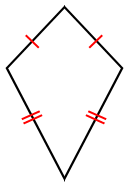
So, you have successfully proved that the angles between the congruent sides in a kite are congruent. We will let you fill in the blanks on your own, but a hint is that this proof is nearly identical to the first proof in this section. If two triangles have three pairs of congruent sides, the triangles are congruent. In addition to the bisecting property, one other property of kites is that the non-vertex angles are congruent.

Congruent supplementary angles are right angles By part 1 above: The diagonal between vertex angles bisects the anglesħ. Now we will prove that the diagonals are perpendicular.ģ. Corresponding parts of congruent triangles are congruent Corresponding parts of congruent triangles are congruentĥ. First, we will prove that one diagonal (connecting the vertex angles) bisects the vertex angles in the kite.Ĥ. Proving this property in general requires using congruent triangles (surprise!).

Therefore, the two line segments are perpendicular. If you think of both of these numbers as fractions, and, you can tell that they are opposite reciprocals of each other. You can also find the slope of using the same method. Remember that the slope is the change in the coordinate over the change in the coordinate. The slopes should be opposite reciprocals of each other.īegin by finding the slope of. To find out whether the diagonals in this diagram are perpendicular, find the slope of each segment and compare them. Show that the diagonals are perpendicular. Perpendicular lines and segments will have slopes that are opposite reciprocals of each other.Įxamine the kite on the following coordinate grid. This can be examined on a coordinate grid by finding the slope of the diagonals. Theorem: The diagonals of a kite are perpendicular In other words, the diagonals of a kite will always intersect at right angles. The diagonals are not congruent, but they are always perpendicular.

The relationship of diagonals in kites is important to understand. Kites have a few special properties that can be proven and analyzed just as the other quadrilaterals you have studied. Kites are defined by two pairs of congruent sides that are adjacent to each other, instead of opposite each other.Ī vertex angle is between two congruent sides and a non-vertex angle is between sides of different lengths. Kites have no parallel sides, but they do have congruent sides. Identify the relationship between opposite angles in kites.Īmong all of the quadrilaterals you have studied thus far, kites are probably the most unusual.Identify the relationship between diagonals in kites.


 0 kommentar(er)
0 kommentar(er)
